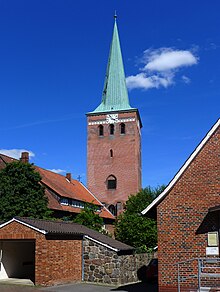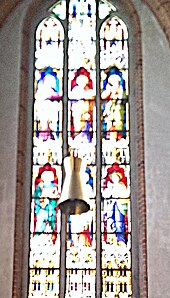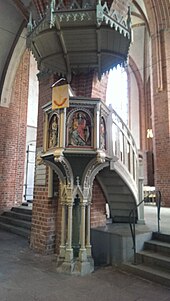St. Marien (Uelzen)
The Gothic St. Marien Church (also St. Marien ) belongs to the Evangelical Lutheran Church in Hanover and is one of the oldest churches in the Uelzen district . In the church district of Uelzen it is the central focus for regional church services and events. The parish includes around 4900 parishioners from downtown Uelzen and the Königsberg district as well as the villages of Hambrock , Halligdorf , Niendorf, Ripdorf and Woltersburg .
Location and surroundings
The St. Marien Church is in the center of Uelzen on the small side street "An der Sankt-Marien-Kirche". Opposite the church is the Uelzen city library. In front of the church is a paved church square, which was previously used as the city cemetery. The pedestrian zone and the Uelzen city library are in the immediate vicinity of the church. There is also the Martin Luther House, which is used as a parish hall, right next to the church. The Ulenköper monument is in front of the church .
architecture
The building, which is impressive in relation to the size of the city, was built between the 13th and 14th centuries in the style of North German brick Gothic . The exact start of construction is unknown. The three-aisled Gothic hall church was consecrated in 1292 by the Bishop of Verden and elevated to a parish church that same year . Opposite the entrance door is the Gothic brick gable of the Propstei . This dates from the first half of the 15th century.
construction
The church was built with a wooden frame, around which a brick facade was built, as well as brick pillars inside the church. Initially, only the low central part of the nave existed as a three-aisled Gothic hall church. It is believed that the high vaults of the central nave belonged to a construction period before 1300. Over time, the church was raised more and more so that citizens of Uelzen could be buried in the cemetery that was around the church. Originally you could enter the church by two steps upwards, today there are five steps downwards.
Steeple
The church has an 86 meter high, square, poorly structured steeple, which was only built after the completion of the high choir . The tower was given a baroque look from 1671 to 1680 after the first big fire in the city, in which part of the church and its library with important documents burned out . The spire burned down in the second major city fire in 1945 and was rebuilt in 1954. The masonry part and the top are each 42 meters high, so that the church tower appears narrow, unlike towers with a smaller tip. The stairs to the top of the tower are very narrow and the 196 steps are small.
Roof truss
A side door in the first section of the tower leads to the Gothic church vaults. Here you can see the walls and herringbone patterns, which were created freehand and without prior formwork. A ladder higher up in the tower leads to the roof structure . However, this can only be viewed in good weather. The roof structure is made entirely of wood and is freely accessible.
Apostle Chapel
To commemorate the deaths of the plague epidemic of 1350, Provost Hermann Nigebuhr donated the Apostle Chapel, consecrated in 1357, on the south side of the church. Due to the delicate shapes and the colored medieval painting, the Apostle Chapel stands in contrast to the main church. The Apostle Chapel is also the burial place of the Ellendorf family and is therefore often called the Ellendorf Chapel.
Epiphany Chapel
After the apostle chapel was added, the Epiphany Chapel was added to the south side of the tower almost a century later. This extension was completed in 1430 and is now used as a place for morning prayers.
pulpit
The neo-Gothic pulpit dates from 1900. Like the main altar, it was created by Conrad Wilhelm Hase . It is located in front of the high choir of the church.
Furnishing
organ
The organ has 53 registers, making it the largest organ on the Lüneburg Heath . It is located above the entrance to the central nave on the west side of the church and was put back into operation on the first of Advent 2001 after several renovations. Overall, the organ was rearranged and structurally changed twice. The reasons for relocating the instrument were the space required for the large oratorical performances and the construction of the side galleries in the central nave. From 1951 to 1954 the organ was “baroque”, which resulted in serious changes to the pipework. The organ and the organ prospectus originally come from Johann Georg Stein from the year 1756; the organ prospectus is Stein's largest preserved organ prospectus. 1960 to 1966 an organ building workshop from Berlin built a new three-manual organ with 40 registers. The sound concept was based on the models of North German baroque organ builders.
In 1997 it was decided to restore the organ because there were many technical defects and the organ had only limited sonic possibilities. The remaining historical parts of the organ were removed. At the same time the organ front was restored and returned to its original condition. The restorations included the original paint layers of the marbling and the retouching of the imperfections. The carving, covered with gold leaf and silver, was also freed from layers of paint, exposed or re-gilded. The description of the Stein organ in a commemorative publication from 1756 and a photo from 1885, which probably showed the organ in its original state, served as a template.
The console is covered with cherry wood, the registers are made of walnut wood and the hand-lettered manubriums are made of porcelain. The organist has access to the typesetting system with 256 combinations and a floppy disk drive to save the typesetting. In total, only 23 of the old registers were taken over, the other 30 were added. As a result of the restoration, new elements can now also be included in the concept, for example the large setting system. Thanks to the restoration of the organ, all pieces from the last epochs can now be played on the instrument.
The organ gallery is opened to visitors when all the naves are full, for example on Christmas Eve . Another small organ was built in the church in 1981 by a Hamburg organ builder, which is used at weddings, funerals or dinner in the high choir. The positive of this small organ can be removed in a few simple steps so that it can be used as a continuo instrument.
Organ data
Disposition: (53 / HW / BW / SW / Ped)
| Main work | Swell | Breast positive | pedal |
|---|---|---|---|
| Quintadena 16 ′,
Principal 8 ′, Viola di Gamba 8 ′, Reed flute 8 ′, Octave 4 ′, Pointed flute 4 ′, Nasat 2 2 ⁄ 3 ′, Large Sesquialtera 2 f., Octave 2 ′, Rauschpfeife 2 f., Mixture 4 f., Trumpet 16 ′, Trumpet 8 ′ |
expanded to g ′ ′ ′ ′,
Bordun 16 ′, Violin principal 8 ′, Viol 8 ′, Vox coelestis 8 ′, Double flute 8 ′, Lieblich Gedackt 8 ′, Fugara 4 ′, Transverse flute 4 ′, Piccolo 2 ′, Quint flute 2 2 ⁄ 3 ′, Third flute 1 3 ⁄ 5 ′, Harmonia aetheria 3 f., Trumpet 8 ′, Oboe 8 ′, Carillon |
Quintadena 8 ′,
Gedackt 8 ′, Principal 4 ′, Salicional 4 ′, Night horn 4 ′, Octave 2 ′, Fifth 1 1 ⁄ 3 ′, Third 1 3 ⁄ 5 ′, Mixture 4 f., Dulcian 16 ′, Vox humana 8 ′,
|
Pedestal 32 ′,
Principal 16 ′, Violon 16 ′, Sub-bass 16 ′, Octave 8 ′, Cello 8 ′, Drone 8 ′, Octave 4 ′, Night horn 2 ′, Mixture, Trumpet 16 ′, Trumpet 8 ′, Klairon 4 ′, Cornett 2 ′, |
Manual range: C – c ′ ′ ′ ′ Pedal range: Cg ′
Coupling III / I; II / I; III / II; Pedal couplings I, II, III; Super- and sub-couplers III / III; III / II; III / I; Sub-coupler II / II
Manual coupling mechanical and electrical, octave coupling electrical, glockenspiel of I, II and III can be played, tuning: * 440 H, equal level, setter with 256 combinations, floppy disk drive, Midi connection.
Data of the choir organ
| manual | pedal |
|---|---|
| Gedackt 8 ′,
Principal 4 ′, Flute 4 ′, Octave 2 ′, Fifth 1 1 ⁄ 3 ′, Sesquialter 2f. (only treble) |
Subbass 16 ′,
Octave 4 ′ |
Paddock
Bells
In the Middle Ages , the bell tower had a six- bell bell , which was destroyed by remelting, fires and the two world wars. In 1949 the “Maria” bell was consecrated. Your reverberation should last about 80 seconds. “Maria” has a diameter of 2.06 meters and weighs around 3500 kilograms. With these dimensions, the bell is the largest in the church's bell tower. In the year the bell was repainted and has far exceeded the average age of steel bells. The age and the large spots of rust that are spreading more and more on it suggest that it will have to be replaced in the next few years, otherwise an important bell in the tower will be missing. It bears the inscription "I am called Maria, I call to God for my country, after war and hardship I rose again, Master Weule's hand, provost and church councilor poured out on me." "Maria" is only rung on Good Friday at the hour of Jesus' death and at funeral services for a deceased provost.
In the 1950s, the community received the Engelbert bell, called "Der Engelbert", an ownerless sponsored bell that was cast in Hemelingen in 1898 . The ringing of St. Mary's Church is completed by the "Queen of Peace", a cast steel bell from the Bochum Association in 1954 and the "Osterglocke", a bronze bell by Friedrich Wilhelm Schilling from Heidelberg , which was cast there in 1953. The two oldest bells in St. Mary's Church date from 1647 and 1695. Two clock bells, which had to be delivered to be melted down for war purposes in 1943 because of the Second World War , came back to Uelzen in 1948 from the “ bell cemetery ” in Hamburg . This relocation of the bells meant that they could not be smashed during the Second World War. For these reasons, a large part of St. Mary's bells was not cast until the 1950s.
Two bells belong to the striking mechanism, which strike at the hour and quarter of an hour. They are connected to the church clock via a radio system. The five others make up the chimes and are vibrated during devotions and on special occasions. The combination of the respective bells also has a meaning. The Engelbert and the daffodil come into action at the baptismal service, the large clock chime and the Engelbert at a wedding. 40 programs have therefore been set up for the whole year and all different occasions. The vibrations of the bells are so strong that they pass onto the masonry. For this reason and for other reasons, cracks appeared in the masonry that had to be renovated. Furthermore, the steel belfry for most bells must be replaced by one made of wood.
High choir and crypt
The high choir and the crypt of the church were built in 1385. The St. Michaelis Church served as a model for the crypt. Attempts were made to imitate the hall crypt of the St. Michaelis Church in the high choir in the form of a small crypt. An upper floor with the octagonal pillars on the opposite side of the sacristy to the south was also taken over from the choir of St. John's Church in Lüneburg . The blind windows were on the exterior. Without the crypt system, the choir disposition was then used together with the octagonal pillars of the Uelzen hall choir in Salzwedel for the planning of a church there. The large altar is in the high choir . The tall stained glass windows that go around the high choir are particularly striking . The pulpit is just before the choir, and the small choir organ is in the high choir. Church services, weddings and other celebrations often take place here.
Art treasures
Paintings
The paintings in the choir vault, which were uncovered and restored in 1962, show the twelve apostles , a mercy seat and Christ enthroned . The colored glass windows also depict scenes from the life of the apostles and were designed by Renate Strasser (1924–2012).
The "Golden Ship"
In a wall niche in the entrance area stands the “Golden Ship”, which is the landmark of the city of Uelzen. It was probably brought to Uelzen at the time of the Hanseatic League . Origin, age and former use are not clear. The golden ship is said to represent a medieval centerpiece and is probably a gift from English merchants. Again it is claimed that the Hanseatic Office of the Stahlhof was closed in 1598 by the British Queen Elizabeth I and that the son of a former mayor Uelzen then brought the centerpiece with him to the city. It is probably a former reliquary . Today it is located in a wall niche next to the tower hall of the church. A duplicate of this ship is in the town hall of Uelzen.
The Annen Altar
The Annen Altar is a Lüneburg carving in the Gothic style. The Annen Altar from 1506 has found its place in the choir of the Apostles' Chapel. At the time of the Reformation there were said to have been a total of 17 altars in the St. Mary's Church. However, due to fires and other circumstances, these altars did not last.
Mary chandelier
The Marian chandelier dates from 1450. It is made of brass and depicts a Gothic double Madonna on a crescent moon and, along with the other lamps in the church, is used for lighting. It is located near the pulpit, centered in the hall.
Tombstones
The outside facade of the church is decorated with tombstones of mayors, pastors and their relatives. The burial grounds used to be on the square of St. Mary's Church, which is why the tombstones of some Uelzen residents now hang on the outer facade.
Grave plaque of the daughter of the mayor of Uelzen from 1636. She died at the age of 12.
Current usage
Church services
The church is used for regular services on Sunday mornings. The “Second Program” takes place about every two months, an alternative, freer service. In addition, the children's church is offered every Saturday on Saturdays. Furthermore, church services for schooling, confirmations and degrees are celebrated here.
Events
Regular choir and organ concerts are performed by regional and national artists. There are also performances by the Kantorei and the Uelzen Chamber Orchestra.
St. Mary's Choir
The supra-community choir has been in existence for over 50 years and currently has 85 singers. In weekly choir rehearsals, two to four oratorio works are rehearsed and performed each year. The repertoire includes pieces by Johannes Brahms or Johann Sebastian Bach, for example, as well as requies by John Rutter , Maurice Duruflé and Andrew Lloyd Webber . The pieces are staged at church services and concerts in St. Mary's Church.
Others
From Easter to Thanksgiving, there is a 20-minute organ prayer every Wednesday.
Tower tours up to the bells and the wooden vaulted roof take place on request and at community festivals and on the day of the open monument .
The facade had to be almost completely renewed from 2012 to 2013 due to the weather.
During a severe thunderstorm on the night of September 7, 2014, the church tower was struck by lightning. As a result, the sound system and exterior lighting of the church were almost completely destroyed and the clock and bell electronics were damaged.
Web links
- Internet presence of the parish of St. Marien
- St. Marien in Uelzen on NDR.de, accessed on March 30, 2015
- Information about the organ
- Uelzen-Kantorat.de , accessed on March 30, 2015
- Information about the organ
- Description on the website of the city of Uelzen
Coordinates: 52 ° 57 ′ 52.8 ″ N , 10 ° 33 ′ 33.8 ″ E




















